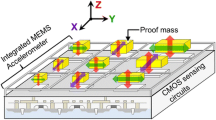Abstract
The authors report a novel MEMS capacitive sensing structure that utilizes a single-layer electroplated gold to achieve simultaneous sensing of biaxial acceleration with low cross-axis sensitivity. The capacitive sensing structure is designed for the in-plane biaxial accelerometer with high frequency ratio and low-g acceleration range. The etching precision of the large proof-mass suspension is guaranteed by the design of detachable supporting islands. Then, different locations are explored in arranging the capacitors, for which the corresponding estimation algorithms are derived. Finally, the proposed structure was fabricated under the commercial MicraGEM-Si platform based on silicon-on-insulator (SOI) technologies. In summary, the structural and fabrication designs of the MEMS capacitive sensing structure solve the problems in biaxial independent sensing, while offering: 3D connectivity of electrodes using planar fabrication technologies; large proof-mass fabrication precision; identical mobility range in all in-plane directions; and sensing algorithms for any regular polygonal shape.






Similar content being viewed by others
References
Aydemir A, Terzioglu Y, Akin T (2016) A new design and a fabrication approach to realize a high performance three axes capacitive mems accelerometer. Sens Actuators A Phys 244:324–333
Aydin O, Akin T (2013) A bulk-micromachined fully differential mems accelerometer with split interdigitated fingers. IEEE Sens J 13:2914–2921
Chiang C, Chang C, Fang W (2014) Design of a digitized vibration detector implemented by CMOS digitized capacitive transducer with in-plane SoI accelerometer. IEEE Sens J 14(8):2546–2556
CMC Microsystems (2014) Design Handbook: Micralyne MicraGEM-Si™ (ICI-319) (online). https://www.cmc.ca/en/WhatWeOffer/Products/CMC-00200-03036.aspx
Comi C, Corigliano A, Langfelder G, Tocchio A (2013) Compact biaxial micromachined resonant accelerometer. J Micromech Microeng 23(10):105012
Hervé J, Sparacino F (1992) Star, a new concept in robotics. In: Proceedings of 3rd international workshop on advances in robot kinematics, pp 176–183
Krishnamoorthy U, Clews PJ, Baker MS, Tanner DM (2008) Challenges of designing and processing extreme low-$g$ micro electrical–mechanical system (MEMS) accelerometers. Proc Soc Photo-opt Instrum Eng (SPIE) 6884:O8840–O8840
Lee JS, Lee SS (2008) An isotropic suspension system for a biaxial accelerometer using electroplated thick metal with a HAR SU-8 mold. J Micromech Microeng 18(2):025036
Merdassia A, Kezzoa MN, Xereasa G, Chodavarapub VP (2015) Wafer level vacuum encapsulated tri-axial accelerometer with lowcross-axis sensitivity in a commercial mems process. Sens Actuators A Phys 15(4):25–37
Qu H (2016) CMOS MEMS fabrication technologies and devices. Micromachines 7(01):14
Shan X, Angeles J, Forbes J (2018) Design of a biaxial high frequency-ratio low-$g$ MEMS accelerometer. Microsyst Technol 24(9):3851–3861
Sun H, Deyou Fang KJ, Maarouf F, Qu H, Xie H (2011) A low-power low-noise dual-chopper amplifier for capacitive CMOS-MEMS accelerometers. IEEE Sens J 11(4):925–933
Tipler P (1982) Physics, 2nd edn. Worth Publishers, New York
Touboul P, Kielbasa R (1999) Capacitive detection scheme for space accelerometers applications. Sens Actuators A Phys 78(2–3):92–98
Tsuchiya T, Hamaguchi H, Sugano K, Tabata O (2009) Design and fabrication of a differential capacitive three-axis SOI accelerometer using vertical comb electrodes. IEEJ Trans Electr Electron Eng 4:05
Wohlhart K (1991) Der homogene paralleltrieb-mechanismus. Math Pannon 2(2):59–76
Xie J, Agarwal R, Liu Y, Tsai JM (2012) A three-axis SOI accelerometer sensing with both in-plane and vertical comb electrodes. Microsyst Technol 18(3):325–332
Yamane D, Matsushima T, Konishi T, Toshiyoshi H, Masu K, Machida K (2016) A dual-axis mems capacitive inertial sensor with high-density proof mass. Microsyst Technol 22(3):459–464
Zhao H, Dai B, Liu X (2015) A new silicon biaxial decoupled resonant micro-accelerometer. Microsyst Technol 21(1):109–115
Zou T, Angeles J (2014) Isotropic accelerometer strapdowns and related algorithms for rigid-body pose and twist estimation. J Appl Mech 81(11):111001
Acknowledgements
We would like to acknowledge CMC Microsystems Inc. for the provision of products and services that significantly supported this research work. NSERC’s support through Grant No. RGPIN-2015-03864 is dutifully acknowledged. NSERC is Canada’s Natural Sciences and Engineering Research Council. FRQNT’s support through the New University Researchers Start-up Program is also gratefully acknowledged. FRQNT is Fonds de recherche du Québec–Nature et technologies. The MEDA scholarship from McGill University supported the first author during her PhD studies on biaxial accelerometers. The second author acknowledges McGill University’s support through a James McGill Professorship (Fund Number 100711) in Mechanical Engineering.
Author information
Authors and Affiliations
Corresponding author
Additional information
Publisher's Note
Springer Nature remains neutral with regard to jurisdictional claims in published maps and institutional affiliations.
Rights and permissions
About this article
Cite this article
Shan, X., Angeles, J. & Forbes, J.R. A novel capacitive sensing structure for simultaneous detection of biaxial low-g acceleration in a commercial MEMS process. Microsyst Technol 25, 4475–4481 (2019). https://doi.org/10.1007/s00542-019-04432-0
Received:
Accepted:
Published:
Issue Date:
DOI: https://doi.org/10.1007/s00542-019-04432-0




